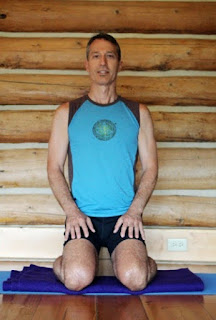 |
| The Boundary is Fuzzy by Marie Lossky |
I’ll start by comparing simple breath awareness to pranayama (breath control). Simple breath awareness is a practice of observing your breath without changing it. With pranayama, you intentionally change your breathing patterns, by making your inhalations and/or exhalations longer, holding your breath, or by breathing in a special fashion (such as humming, alternating nostrils, and so on), which has a potentially stronger affect on your nervous system (see Pranayama: A Powerful Key to Your Nervous System). With simple breath awareness, you just watch your natural breathing patterns, which is both very effective and completely safe.
Breath awareness can be used in two different ways. The first is as a stress management technique. Ten to 20 minutes of simple breath awareness will trigger the Relaxation Response, quieting both your nervous system and your mind. And even a few minutes of practice can help center you or head off a spike in your stress levels. The second is as a meditation technique.
Whether you are practicing for stress management or as a form of meditation, the way you practice will depend on your location and position. If you’re going to practice as meditation, see Yoga Meditation Techniques for options for location, position, and timings. See the end of this post for information on choosing a focus, as this applies to both forms. This post provides information about location and positions for stress management. At the end of the post, I’ll provide information on choosing a focus for both forms of practicing.
Choosing Your Location
You don’t need a special location to practice breath awareness. As long as there is a quiet spot for you to sit—whether on the floor, out in nature, or on a chair—you can practice. You can also practice breath awareness while you are doing your favorite restorative pose or even while you are in bed as a way to soothe yourself to sleep (or back to sleep if you are awake in the middle of the night).
And when you’re traveling or are stuck somewhere busy and noisy, such at your office or on a train or airplane (yes, I’ve done that), you can practice there, too. It’s more challenging to practice when there are distractions or you are in a public place, but it is still an effective way to calm yourself in the middle of a hectic day.
Choosing Your Position
The position you choose will depend on your location. You have the most options in a house, where you can practice in a yoga sitting pose, sitting on a chair, in a restorative pose, or lying in or on your bed. Obviously, if you are at work or some other public place, you may have to limit yourself to sitting on a chair.
The position you choose will depend on your location. You have the most options in a house, where you can practice in a yoga sitting pose, sitting on a chair, in a restorative pose, or lying in or on your bed. Obviously, if you are at work or some other public place, you may have to limit yourself to sitting on a chair.
Sitting. Our recommended positions for seated breath awareness are Seated Crossed Legs and Hero pose (although a few people are comfortable enough in Half Lotus or even Full Lotus to practice breath awareness in those poses).
In his post Learning to Sit on the Floor, Baxter described how you can use props to get comfortable in these poses.
For people who can’t get comfortable on the floor or if the current setting doesn’t allow it, sitting on a chair is always an option. But rather than leaning against the back of the chair and slumping, sit on the front edge of the chair with your feet flat on the floor (if you are short, you might need to put a prop under them or if your legs are long you might need to put some padding on the chair seat) and your spine in its natural curves and your head in line with your spine. Obviously someone with physical disabilities who is in a wheelchair can practice breath awareness in whatever position they are able to take, in whatever chair they happen to be.
Restorative yoga poses. You can practice breath awareness in any restorative yoga pose that you find comfortable, as well as in gentle supported inverted poses (see All About Supported Inversions), such as Legs Up the Wall pose. We especially recommend Reclined Cobbler’s pose and Supported Savasana, if those poses are comfortable for you. I, myself, have found the combination of Legs Up the Wall with breath awareness to be extremely powerful.
If you’re someone who tends to be anxious and lying on your back makes you feel vulnerable or if you can't lie on your back for any reason, Supported Child’s pose or a Side-Lying Savasana are good alternatives. Both will allow you to bring awareness to your breath in your back body, which can be more relaxing for anxious people.
In bed. You can practice breath awareness under the covers in your bed, in your customary sleeping position. This is a good way to improve your sleep because you will fall asleep in more relaxed state or to get back to sleep if you wake in the middle of the night (see Yoga You Can Do In Bed). Depending on what’s most comfortable for you, practice either on your back with your head supported by a pillow or lying on your side, with a pillow between your legs.
Standing. If you just want to center yourself—or help head off a spike in stress—you can practice breath awareness any time and any where in Mountain pose (Tadasana). This position is best for a short session of breath awareness, as standing still for 10 to 20 minutes is very challenging. But it’s excellent for a quick fix!
Choosing Your Focus
So what does it mean to bring your awareness to your breath? There are actually many options as you explore either the quality of your breath or the way your breath moves in your body. Try out the various techniques listed below to find one that engages your attention and also that doesn’t make you feel anxious about your breathing. As you observe your breath, consciously refrain from changing it. You may notice, however, as time goes on, that your breathing patterns may change on their own because you are relaxing more and more.
Feeling your body respond to your breath. For beginners, probably the easiest way to observe the breath is to watch the dramatic way your body moves as your lungs expand and shrink. As you inhale and exhale, you can watch your belly rise and fall, your chest expand and shrink back, or your ribs move out to the sides and back again. In positions where you are lying on your side or are prone (like Child’s pose), an interesting option is to feel your back expand and fall back with your breath, and this may be more soothing for those who tend to be anxious.
Sound. If it is quiet enough, you can focus on listening to the internal sounds you hear as you breath in and out.
Feeling your breath. The best way to “feel” your actual breath is to bring awareness to the nostrils, sensing the air flowing in and out of them. You can also notice the quality of the breath moving in and out of your lungs. Is it smooth or rough? Relaxed or forced? Is your exhalation or inhalation longer? Or are they the same?
As you watch your breath, be sure to maintain a non-judgmental attitude about your ability to concentrate. If you want to trigger the Relaxation Response, continue practicing for 10 to 20 minutes. If you just want to center yourself, a shorter period of time will be effective, even for just one minute. If you practicing as a form of meditation, see Yoga Meditation Techniques.
Subscribe to Yoga for Healthy Aging by Email ° Follow Yoga for Healthy Aging on Facebook ° Join this site with Google Friend Connect





